You’re looking for the right bass amplifier to fit your style, sound and specific needs, and you’re in need of some trustworthy intel. Whether you’re just starting out and looking for your first amp, or a seasoned pro looking for the ideal stage or studio rig, we can help you navigate the world of combos, heads, tubes and hybrids to find just the right thump for your sound and budget.
Today, we’ll look at all the basics of bass amplification, from tube and solid-state technology to choosing a combo or head and cabinet. Is the same amp you practice with the right one for the stage? What’s the difference between recording with an amp or a DI? What the heck even is a hybrid amp?
Whether you’re looking for a tried-and-true classic or the latest in thunderous tone-shaping wonders, we can help you locate the right rig for the job.
Table of Contents
A Quick History of Bass Amplification
Tube, Solid-State and Hybrid: The Differences
A Glossary of Bass Amp Terms
Best Bass Amps for Beginners
Acoustic B25C Bass Combo With Tilt-Back Cab
Fender Rumble 25 Bass Combo Amp
Ampeg Rocket Bass RB-108 Bass Combo Amp
VOX Pathfinder Bass Combo Amp
Best Practice Bass Amps
Markbass CMD JB Players School 200-Watt Bass Combo Amp
Orange Crush Bass 100 Bass Combo Amp
Fender Rumble 500 Bass Combo Amp
Peavey MAX 300 Bass Combo Amp
Best Bass Amps for Recording
Darkglass Alpha•Omega 900 Bass Amp Head
Ampeg Heritage 50th Anniversary SVT Tube Bass Amp Head
Gallien-Krueger Legacy 800 Bass Amp Head
Best Bass Amps for Live Performance
Ampeg SVT-7 PRO Bass Amp Head
Aguilar Tone Hammer Bass Amp Head
Markbass CMD 102P IV Tilt-Back Bass Combo Amp
Ampeg Rocket Bass RB-210 Bass Combo Amp
In Closing
A Quick History of Bass Amplification
To understand where we are today, we need to understand where we came from. Two of the biggest names in bass, Ampeg and Fender, were the first innovators in bass amplification. The 1949 premiere of the Ampeg Super 800, soon followed by Fender’s 1952 release of the Bassman, set the standard for the industry by being the first truly viable gigging amp choices for bass players.
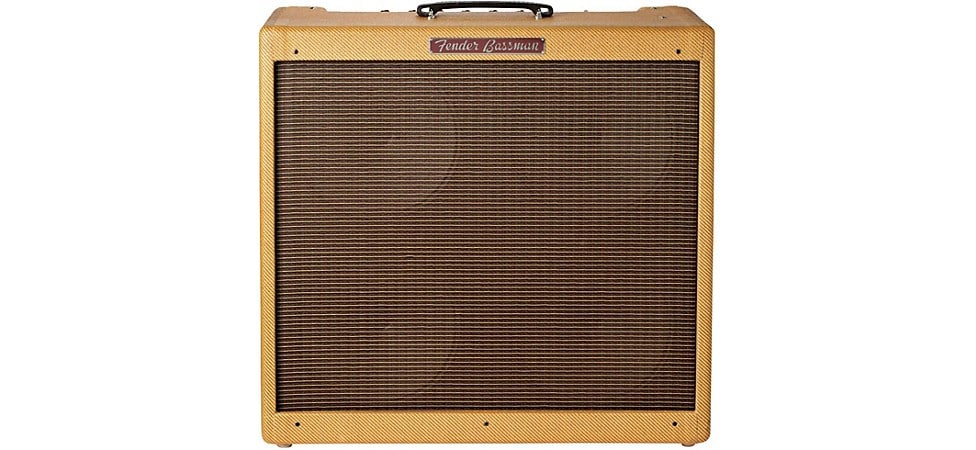
Pictured: Fender Vintage Reissue '59 Bassman LTD 4x10 Combo Amp
In 1960, Ampeg released the B-15 Portaflex, also known as the “flip top,” the gold standard of bass amplification favored by the biggest studio players in Detroit, Memphis and Los Angeles. It’s the holy grail of vintage bass amps today.
The 1960s also brought along solid-state technology. Where previous amps had all been tube-driven and powered (just like guitar amps), solid-state transistors made it possible to make lighter, more durable amps. VOX spearheaded this drive with their T.60, but soon the names you’ve grown to associate with bass amps entered the market, including Acoustic and Gallien-Krueger—the latter beginning with Bob Gallien’s GMT 226B, one of the most powerful bass amps of the ’60s.
You’ve probably heard the term SVT a lot when people talk about bass amps, but you may not really be sure what it means. Super Valve Technology was introduced by Ampeg in 1969, and it’s a tube technology that provides substantially more power, translating into volume and projection. Ampeg’s SVTs became the popular tube amplification choice for bass players throughout the 1970s, while solid-state aficionados flocked to the Acoustic 360 stack; a 200-watt head and massive rear-firing 18” speaker. Thus began the era of arena rock.
In the 1980s, bassist Dave Boonshoft was on the lookout for a bass preamp with the hi-fi quality of the preamps in Neve recording consoles. He met designer Alex Aguilar, and the next generation of bass amp technology was born. Aguilar Amplification pioneered onboard bass preamps, hum-free single-coil pickups and much more.
From the 1980s to the 2000s, bass amp technology continued to evolve and diversify. Big names like Peavey and Orange entered the field, as well as newcomers like Markbass and a host of boutique brands. Meanwhile, brands like Fender, Ampeg and Gallien-Krueger continued to push boundaries.
Tube, Solid-State and Hybrid: The Differences
The tube vs. solid-state debate has raged over the decades. Players love the warmth and power of tube amps, but appreciate the dependability and depth of solid-state amplification. Their sonic qualities are different, as are their practical applications. Often, players choose a tube amp for the studio and a solid-state or hybrid for the road.
What about the sound? Generally, players consider tube amps to sound warmer and more organic. Plus, their natural grit when pushed to overdrive feels crunchy without losing its roundness. Solid-state amps have traditionally been considered to sound less round and warm, and their natural overdrive harsh. But it’s vital to note that their built-in circuitry means it’s easy to add in effects that tube players would need to rely on pedals for—and this includes great overdrive, EQ and tone-shaping technology. With today’s advances, it can be hard to tell the difference between the two with your eyes closed.
Ok, so what is a hybrid? Hybrid amps bridge the tube/solid-state divide. Combining the warm sound of a tube preamp with the stability (and light weight) of a solid-state power amp, these are the Goldilocks of bass amps—not too heavy, not too brittle—when you overdrive them.
A Glossary of Bass Amp Terms
We’ve already begun throwing around terms like watts and heads. Let’s get some of them defined before we dig into the amps. That way we can dispense with the technical talk and dig into the most important thing—the sound you want and the gear you need.
What’s a Watt, and How Many Do I Need?
Watts are how you measure energy in electricity—it’s the amount of energy that an electrical device burns per second. The average light bulb runs at around 60 watts, while a microwave usually works between 600 and 1,200.
You’ll see bass amps that run anywhere from 20 to 2,000 watts. What do you need? We’ll discuss that when we break down different types of amps below. But a good rule of thumb is that you’re going to need about twice as many watts as your guitarist.
Tubes and Valves
Tube amps rely on vacuum tubes (the English call ‘em valves) to amplify the signal coming from an instrument. There are a couple of different kinds of tube amps. Class A amps distort a little sooner and produce a lot of overdrive warmth. When you crank them all the way, you get saturated deliciousness. Class AB amps are “bassier,” and you can push them a lot harder before they distort—a notable detail for bass players.

Pictured: Electro-Harmonix 6550 Matched Power Tube
Despite their incredible tone, one of the downsides of tube amps is that they will require a bit of periodic maintenance to keep them running their best. Like most things, tubes have a shelf life, and the harder you push them, the sooner they’ll need replacement. Of course, this doesn’t have to be a bad thing. A new set of tubes can have your amp sounding like it’s fresh out of the box. Additionally, you can also swap in tubes from different manufacturers, adding in a little tonal variety.
One final note: As compared to solid-state amps, tube amps can get a little heavy. Combined with the size of speakers you need for a bass, it’s possible for rigs to get slightly unwieldly.
Solid-State
These amps use transistor circuits to convert and amplify your signal. Like tube amps, they use two stages, preamplification and power amplification. You can push a solid-state amp much harder before it distorts. Also, solid-state amps tend to be significantly lighter and typically require less maintenance than tube amps.
Speakers and Speaker Cabinets
Speaker size doesn’t always translate to bassiness or depth. Rather, it works in tandem with the power behind it to better fill a room. A 10” speaker can sound just as big as an 18” in the right setting.
Bass amp speakers come in 8”, 10”, 12”, 15” and 18” sizes, and in all combinations thereof. For the most part, 10” speakers are considered to sound punchy, while 15” speakers are considered round and full.
Combo
This is a bass amp that combines the solid-state, tube or hybrid amplifier with the speaker in a single housing. Your all-in-one choice.
Head
A head is a standalone amplification. It’s the preamp, power amp and EQ control in a single carriage that you can pair with a separate speaker cabinet. This lets you choose different cabs for different applications, or, if the amp has a Direct Out, can run directly into a PA or recording rig.
DI
Direct Input. You may be thinking of it as the little box the acoustic guitarist plugs into at the gig, but a bass-specific DI is incredibly useful for bass players. Many modern bass amps include their own DI output, so you won’t even need a standalone DI box.
Upright and acoustic bassists often use it to run directly into the PA onstage, and a sound engineer may use one in combination with your miked amp to get a fuller sound for the mix. In the studio and on stage, it’s used to easily and accurately capture the bass signal.
Impedance
That’s where the horseshoe symbol (Ω) comes into play. Ω is the symbol for ohms, which is the measure of electrical resistance (impedance) in your gear. This is particularly important when it comes to matching amps with external or extension speaker cabinets.
Improper impedance matching can lead to your amp not seeing as much resistance as it expects, which can result in significant, and costly, damage. Additionally, you may see that some amps will output different wattages at different impedances. In general, your best bet is to consult your amp’s documentation to understand the best way to hook it up to any external cabinets.
Connections
There are two types of connections between amps and speakers commonly used for bass amps.
The first type of connector is the standard 1/4” connector, just like the one on your bass. Importantly, you must use a speaker cable for this connection, not an instrument cable. Instrument cables are not designed to carry that level of current, and using them can actually result in the cable melting, in addition to potential damage to your amplifier.
The second type of connector is speakON, which looks a little similar to a microphone XLR connection. SpeakON connectors carry a higher current than 1/4” and the connectors lock in, meaning an excitable singer isn’t going to kick your cable loose. You’re more likely to encounter these connectors in exceptionally high-wattage amps.
Best Bass Amps for Beginners
If you’re just starting out, all of this can be overwhelming. Fortunately, we have some good guidelines of what to look for, as well as some choice options for you.
A beginner’s amp is budget-friendly—often less than $200. The wattage typically stays below 50, and your speakers will likely be either 8” or 10”. Inclusion of headphone jacks in the amp are very beginner-friendly, especially for nighttime bedroom practice, and Bluetooth or AUX inputs give you some versatility. All of the beginner options we’re highlighting today feature headphone jacks.
Acoustic B25C Bass Combo With Tilt-Back Cab
A top choice is the Acoustic B25C 1X8 25W Bass Combo With Tilt-Back Cab. It delivers just the right amount of power for practice and jamming with friends, and easily tilts back like a stage monitor for even better projection from that 8” ferrite speaker. It features simple 3-band EQ control and it also boasts an overdrive circuit and a handy Shape switch that provides quick midrange tone shaping. And the 25 watts of power are just right for getting great tone but not losing your roommates.
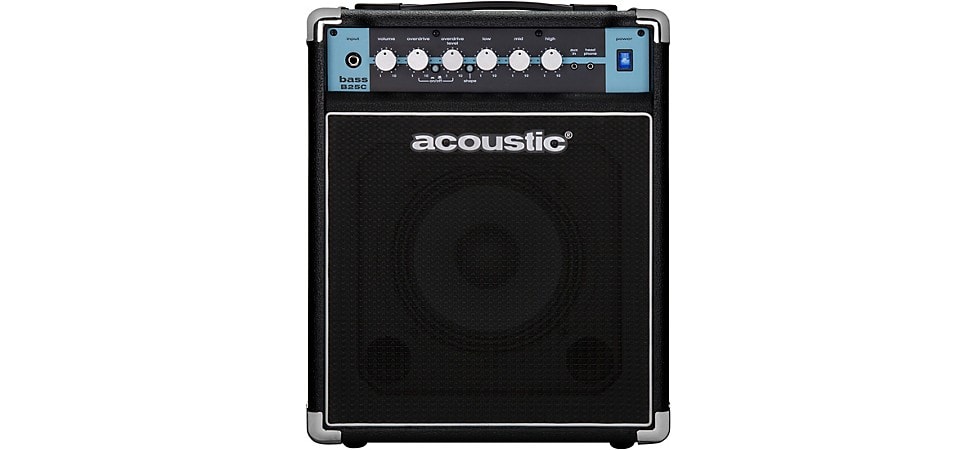
Pictured: Acoustic B25C Bass Combo With Tilt-Back Cab
Fender Rumble 25 Bass Combo Amp
The Fender Rumble 25 1x8 25W Bass Combo Amp is another prime 25-watt, 8” speaker combo. It delivers the trusty round Fender tone we love, and carries a lot of power and volume for its modest footprint.
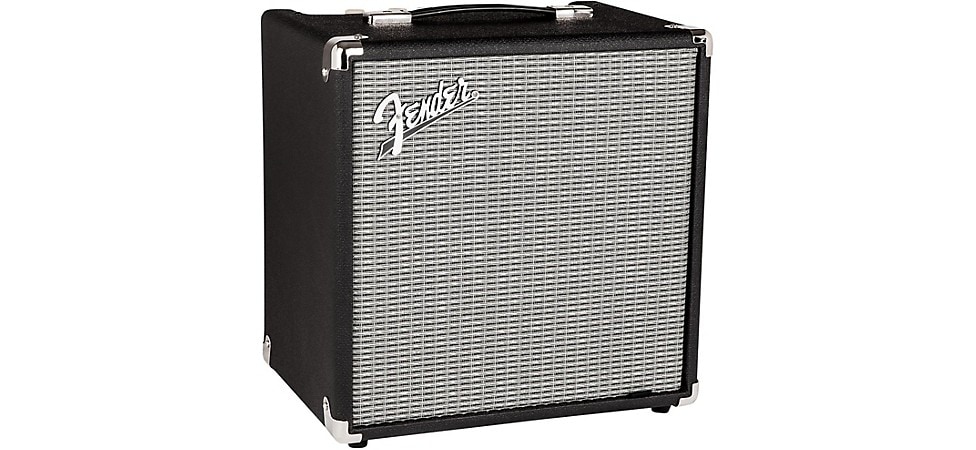
Pictured: Fender Rumble 25 Bass Combo Amp
Ampeg Rocket Bass RB-108 Bass Combo Amp
Ampeg’s Rocket Bass series is appealing for a lot of reasons—vintage style, portability and heaps of luscious Ampeg bass sound. The Ampeg Rocket Bass RB-108 1x8 30W Bass Combo Amp is a 30-watt beauty that uses the same Ampeg Legacy preamp as pricier models, and includes Super Grit technology for a scrappy overdrive crunch.

Pictured: Ampeg Rocket Bass RB-108 Bass Combo Amp
VOX Pathfinder Bass Combo Amp
The VOX Pathfinder 10W Bass Combo Amp is an offshoot of the widely loved Pathfinder guitar amp (a little solid-state marvel). This bass version boasts two 5” Bulldog speakers that really make the most of the amp’s modest 10 watts. Surprisingly loud and full, it also boasts a Drive option for a little extra something.
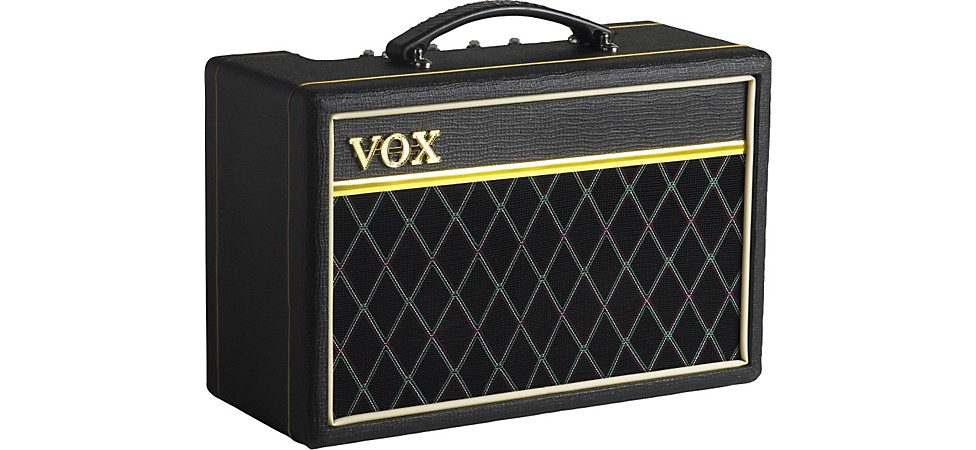
Pictured: VOX Pathfinder Bass Combo Amp
Best Practice Bass Amps
Practice amps are a special and important breed—bigger and more powerful than beginner’s amps so that they can compete with drums, guitars, etc., but not so big that they’re sonic overkill or a nightmare to lug around.
Typical prices hover in the $300–600 range and the wattage often stays in the 100- to 200-watt range, although we’re including some more robust options here. This is where 12” and 15” speakers begin to come into play, in addition to 10” options. Again, headphone outputs and additional input options increase the bang you get for your buck.
Markbass CMD JB Players School 200-Watt Bass Combo Amp
We recommend the Markbass CMD JB Players School 200W 1x15 Bass Combo Amp. It’s compact enough to work in your room, but with a 15” speaker pumping 200 watts, it packs more than enough punch for a rehearsal. Plus, the XLR output means you can record or run into a PA directly, adding to its versatility. The built-in Markbass Vintage Loudspeaker Emulator (VLE) rounds down your highs, fattening mids and lows, and pumping some nice vintage-style tone.
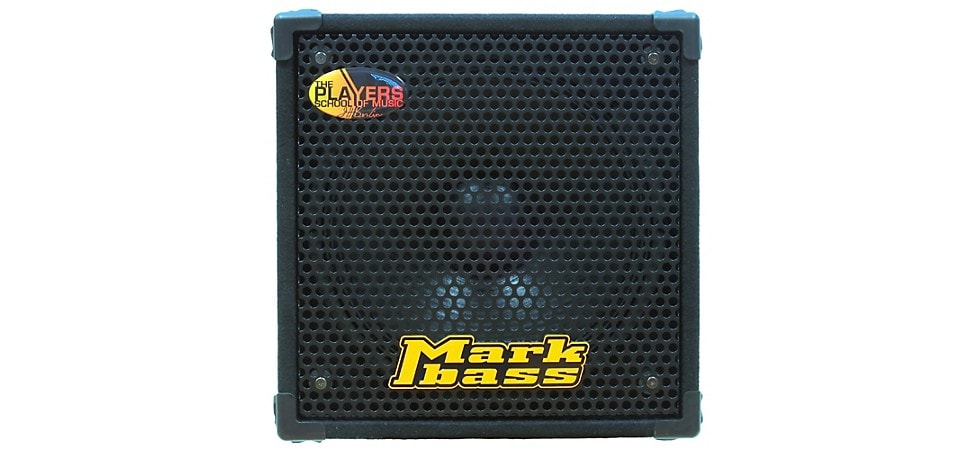
Pictured: Markbass CMD JB Players School 200-Watt Bass Combo Amp
Orange Crush Bass 100 Bass Combo Amp
The Orange Crush Bass 100 100W 1x15 Bass Combo Amp is the little cousin of powerful and popular Orange 4 Stroke and OB1 series bass amps. It’s powerful enough for small venues, and produces voluptuous bass tone and sonic detail, thanks to active EQ and a bi-amp-inspired Gain and Blend circuit. Oh, did we mention the built-in effects loop and tuner?
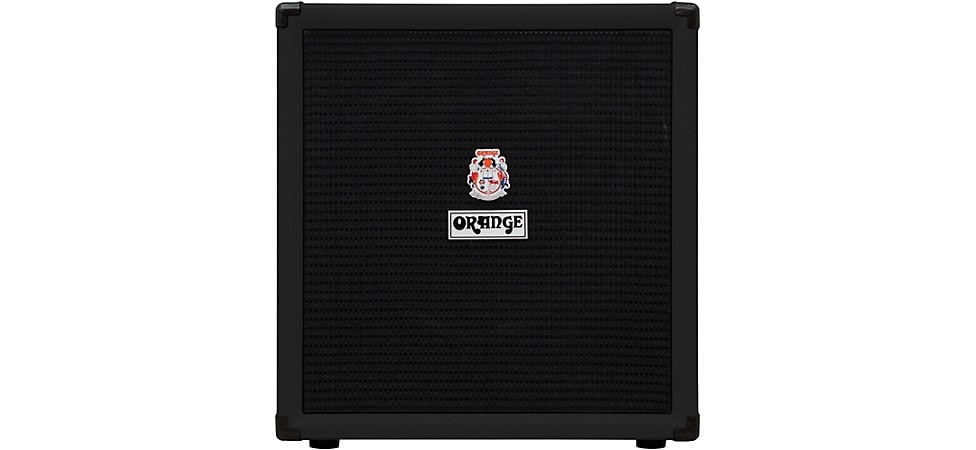
Pictured: Orange Crush Bass 100 Bass Combo Amp
Fender Rumble 500 Bass Combo Amp
Fender steps up to the plate again with the Fender Rumble 500 2x10 500W Bass Combo Amp. At first glance, 500 watts might feel like overkill for a practice amp. But at this price, a powerhouse like this that can double as a gig amp is worth noting. It features two 10” Eminence-designed speakers, 4-band EQ, overdrive, an effects loop and a vintage tone switch.
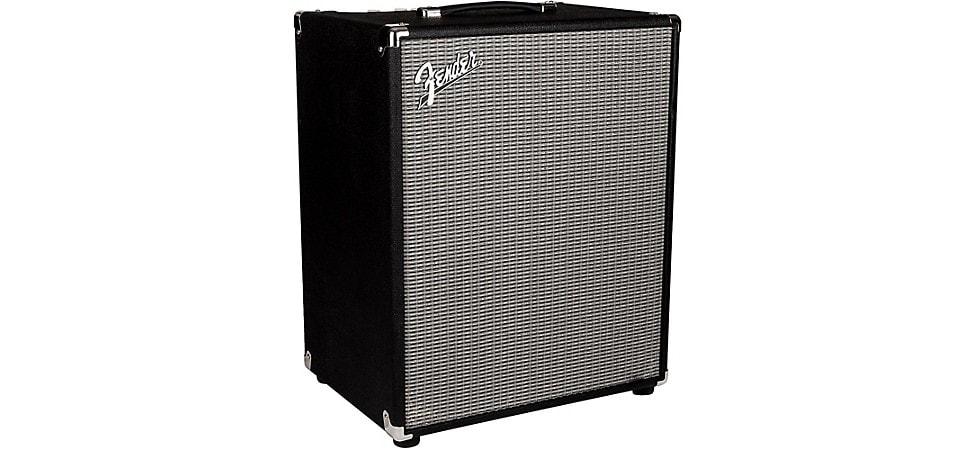
Pictured: Fender Rumble 500 Bass Combo Amp
Peavey MAX 300 Bass Combo Amp
If you’re looking for rugged and dependable, the Peavey MAX 300 300W 2x10 Bass Combo Amp is your buddy. With a housing built for punishment and Peavey’s DDT speaker protection, which compresses your signal when you’re pushing it hard, this amp can handle nearly anything. Plus, Peavey’s Trans Tube circuitry is designed to provide tube-like warmth with solid-state convenience.
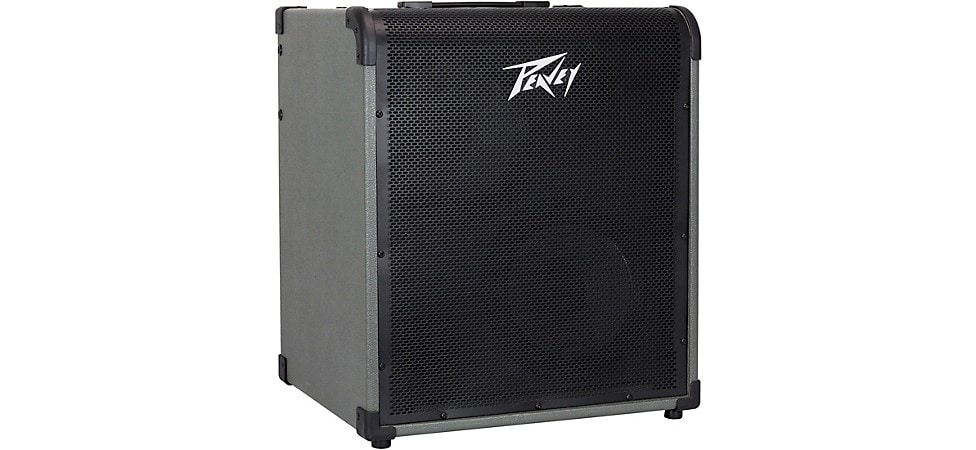
Pictured: Peavey MAX 300 Bass Combo Amp
Best Bass Amps for Recording
Quality and sonic personality are at the forefront in choosing an amp to record bass. Before your signal even goes into the board or the computer, you want the best possible sound. Versatility is also huge here, especially if you are a session player recording with different artists in different genres.
Wattage and speaker size can be nearly anything in recording amps, because you’re working in a very controlled environment. This is the first time in this guide we’ll recommend some amp heads, because they work just as well as combos for recording—just remember to budget for a speaker cabinet to go with it.
Darkglass Alpha•Omega 900 Bass Amp Head
With a jaw-dropping 900 watts of power, the Darkglass Alpha•Omega 900 900W Bass Amp Head is a beauty of a beast. Darkglass combined elements of their hugely popular Alpha and Omega distortion engines with cutting-edge features, including Bite and Growl modes, built-in compression and an impulse response cabinet simulation that let you store up to three virtual cabinets—that means you can dial in your entire rig sound before it even hits a speaker or a recording device.
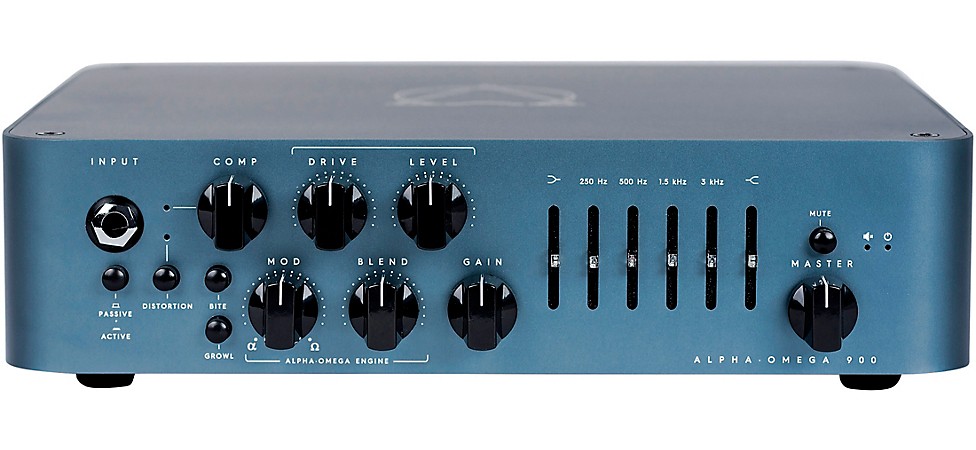
Pictured: Darkglass Alpha•Omega 900 Bass Amp Head
Ampeg Heritage 50th Anniversary SVT Tube Bass Amp Head
The Ampeg Heritage 50th Anniversary SVT 300W Tube Bass Amp Head revisits the industry-changing debut of Super Valve Technology—the moment bass players finally had the power to compete with walls of guitar amps. This model features the tone of the 1969 Blueline original and the mid-1970s Magnavox design, plus the option to blend the two. This beauty is made in the U.S.A., and boasts modern improvements, including a fan to promote tube longevity and speakON outputs.
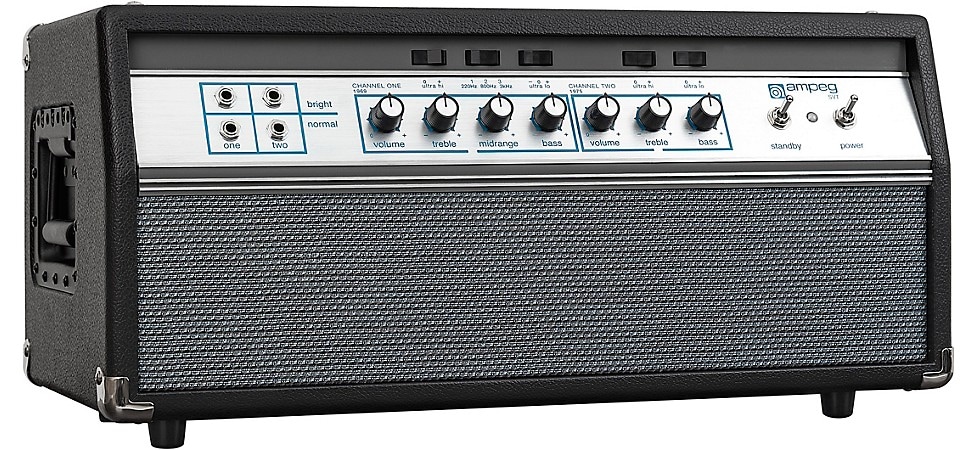
Pictured: Ampeg Heritage 50th Anniversary SVT Tube Bass Amp Head
Gallien-Krueger Legacy 800 Bass Amp Head
Gallien-Krueger also revisits a landmark amp with the Gallien-Krueger Legacy 800 800W Bass Amp Head. The 800RB was a breakout hit in the 1980s, admired for its power, clarity and growl. This model captures all of that while adding modern advancements, including gold-plated connectors, to protect against the damage of temperature extremes and vibration from frequent use. It also boasts Bump, Contour and Presence voicing features.
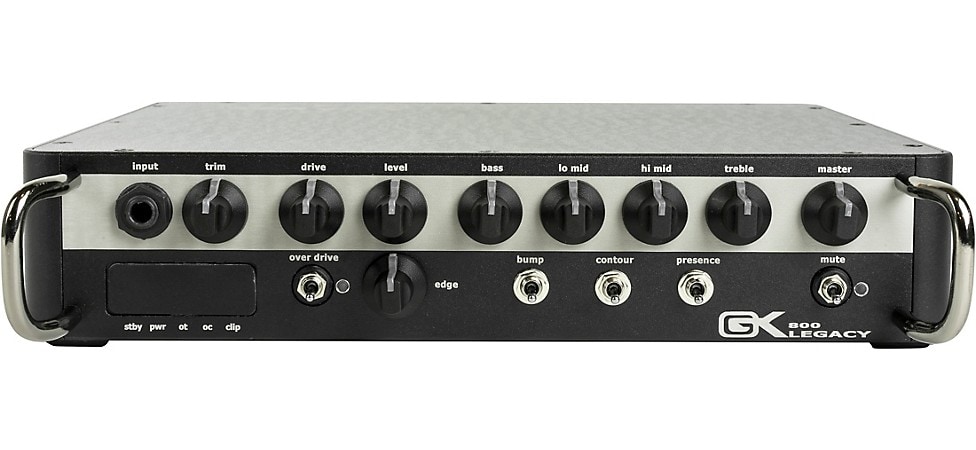
Pictured: Gallien-Krueger Legacy 800 800W Bass Amp Head
Best Bass Amps for Live Performance
While power is a prime driver in the choice of a gigging bass amp, that doesn’t mean it has to come at the expense of tone and subtlety. The size of the venues you typically play and the amount of traveling you do are important factors, too—you don’t need to lug a giant stack across town to play a coffeehouse, but you’ll struggle to be heard with a small combo in a club with a loud band and boisterous crowd.
Gigging amps generally range from $750 to upwards of $3,000, and if you consider the heads we recommend below, you’ll need to account for the additional cost of a speaker cabinet. Also, some venues provide backline gear, in which case you can just bring your head and plug into their provided cabinet. Call ahead to make sure that their cab will be a good fit for your amp.
Ampeg SVT-7 PRO Bass Amp Head
What can we say about the Ampeg SVT-7PRO 1,000W Class-D Bass Amp Head? It. Is. Loud. We’re talking 1,000-watts-of-delectable-Ampeg-tone loud. The built-in compressor keeps your volume consistent, and outputs that combine speakON and 1/4” connection give you added versatility. It’s only 15 lb., which is insanely light. If you’re intrigued, consider this head and cabinet bundle with four 10” speakers.
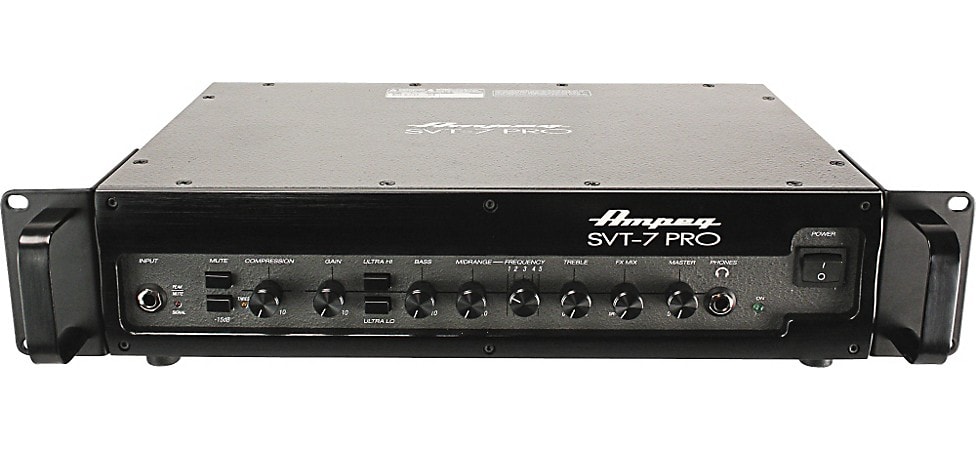
Pictured: Ampeg SVT7Pro Bass Amp Head
Aguilar Tone Hammer Bass Amp Head
The Aguilar Tone Hammer 500 Bass Amp Head is based on their popular Tone Hammer pedal, which is one of the most respected, tone-saving DIs on the scene. This head combines the pedal’s tonal versatility and gain-shaping circuitry with 500 watts of pure power. Whether you prefer velvety round tone, biting overdrive or cutting solo bass sounds, this puppy can give it to you. It boasts both speakON and XLR outputs, meaning you can run it directly into the PA, just like a DI.
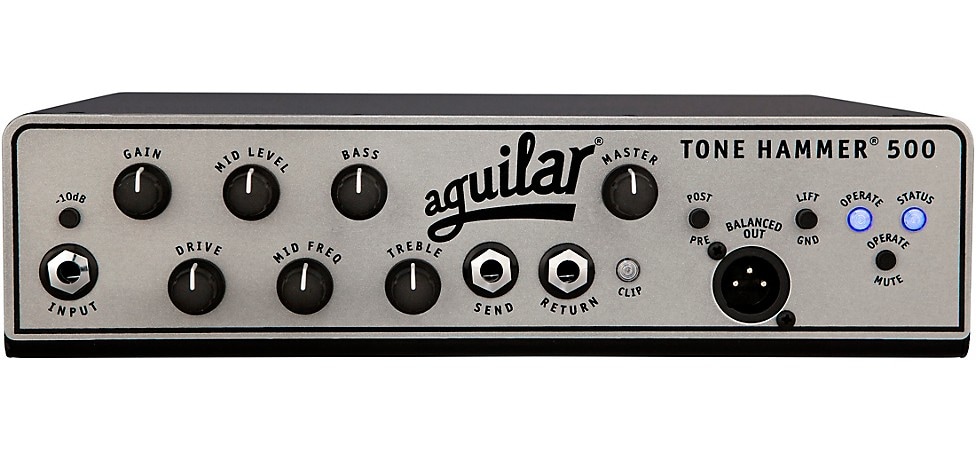
Pictured: Aguilar Tone Hammer Bass Amp Head
Markbass CMD 102P IV Tilt-Back Bass Combo Amp
In the combo arena, the Markbass CMD 102P IV provides 300 watts of power courtesy of two 10” neodymium speakers in a housing that tilts back like a stage monitor for fantastic projection. It makes the most of its updated 4-band EQ, and it features a piezo tweeter to project your treble and high mids, cutting through competing sound.
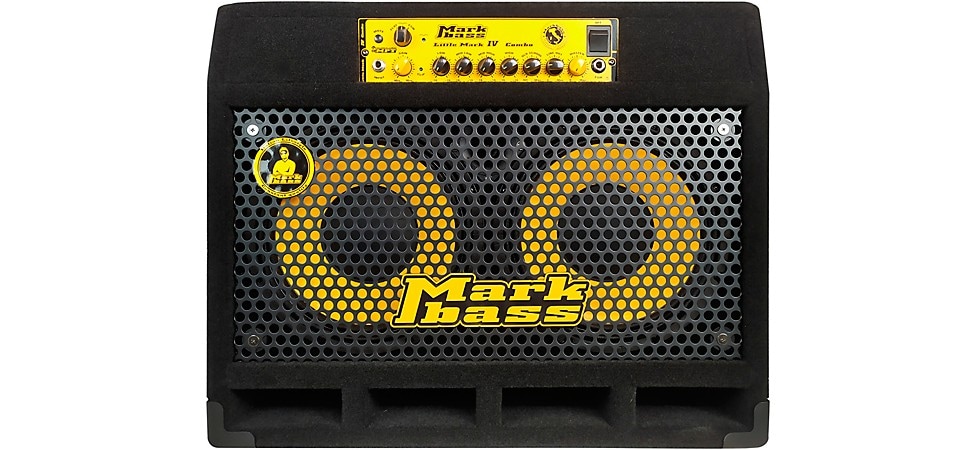
Pictured: Markbass CMD 102P IV Tilt-Back Bass Combo Amp
Ampeg Rocket Bass RB-210 Bass Combo Amp
The Ampeg Rocket Bass RB-210 2x10 500W Bass Combo Amp has vintage good looks, Super Grit overdrive and two 10” Eminence speakers to proudly broadcast 500 watts of power. This combo captures all the best elements of gigging, recording and practice amps, with headphone out, XLR out and AUX input.
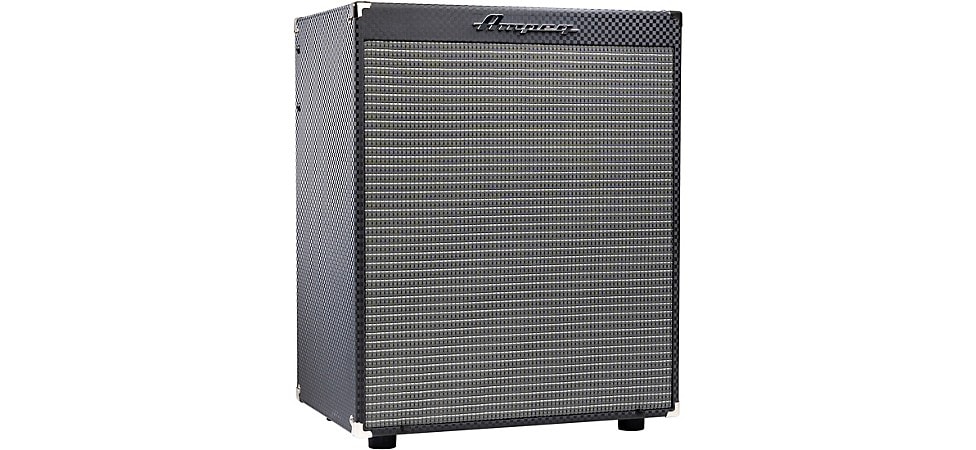
Pictured: Ampeg Rocket Bass RB-210 Bass Combo Amp
In Closing
Despite the vast array of options, the best bass amp for your specific needs can be pretty simple to find. Just try some out. Head down to your local Guitar Center and plug into a few of these options and judge for yourself. Trusting your ear, your unique style and your preferred sound will always lead you in the right direction.
Also, the classic amps we mentioned at the beginning often pop up in our vintage collection, and we’re always adding to our arsenal of used gear, so keep an eye out.




